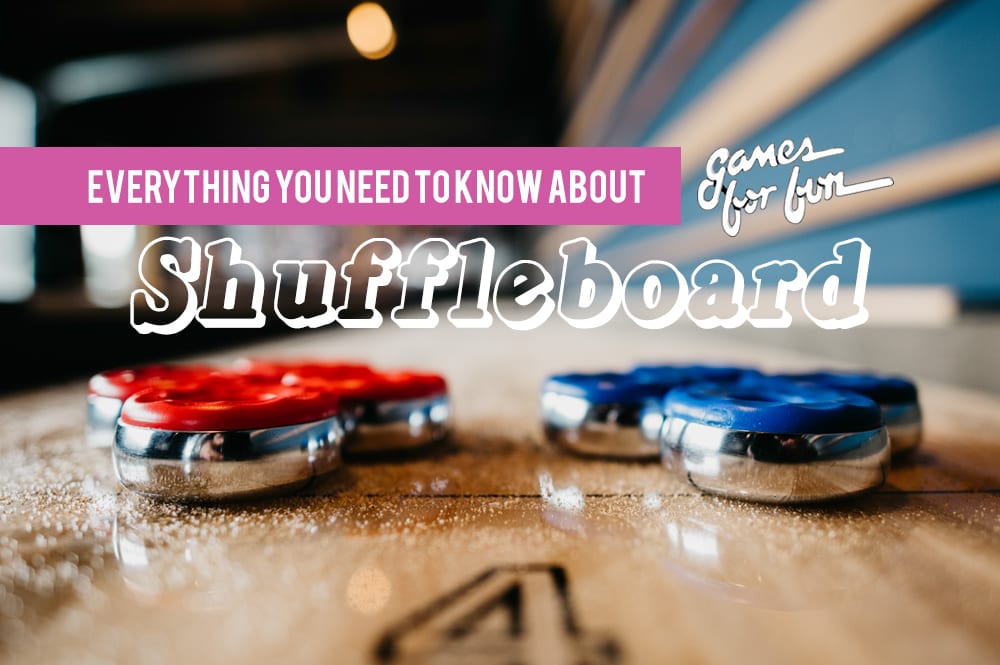From the history of shuffleboard to the rules of the game and beginner-friendly tips for success, learn just about everything you need to know about shuffleboard.
What started off as a popular 15th-century aristocratic pastime in England is now what we know as shuffleboard (also shovegroat, slide-groat, and shovel-penny). In this game, disks are shoved by hand or with an implement so that they come to a stop on or within a scoring area marked on the board or court (on a table, floor, or outdoor hard surface such as concrete).
Shove-ha’penny, a later version of shovel-penny, is played when a coin or disk is pushed along a polished board so that it stops between closely ruled lines. This version is still a popular game in English pubs and, hey, if you’re reading from the States, maybe you could make it popular here!
But, how did the game shuffle it’s way into America in the first place? Well, shuffleboard was introduced to Daytona Beach, Florida in about 1913 as a game on land. The game was so popular that it spread rapidly through the United States, particularly in retirement communities, with each community devising various rules of play. The modern form of shuffleboard was defined at St. Petersburg, Florida, in 1924 — the same place that the National Shuffleboard Association was founded seven years later in 1931.
This society adopted the “official” rules of the game, also later defining the size and shape of courts (concrete or terrazzo, 6 by 52 feet ); the maximum length of the cues (6 feet 3 inches ); the disks (either wood or composition, 1 by 6 inches ; four red, four black); and methods of play and scoring.
Fun shuffleboard fact: In modern times, a modified form of the old indoor game became popular among travelers on ocean liners and cruise ships as a deck game. For the shipboard version, called shuffleboard, courts of various designs were marked on the deck, with lined sections at either end, numbered 1 to 10; the section nearest the player, called 10 off, reduced scores by 10.
Equipment Used and Present-day Game Rules
Here’s the rundown: The object of a regular shuffleboard is to slide, by hand, all four of your shuffleboard weights alternately against those of your opponents to the highest scoring area without the weights falling off the end of the shuffleboard into the alley. Only the winner receives a score.
To be the winner, your weight (or weights) must be further down the board than your opponent’s. You can achieve this by knocking off your opponent’s weight (or weights) or by outdistancing them on the board. The Hammer is the last shot in the frame (or round). The person or team who has the Hammer in any given frame is considered to be on the defensive. In other words, it is an advantage to shoot last.
Shuffleboard may be played by two people (singles) or four (doubles), shooting alternately with red and black disks. Game may be 50, 75, or 100 points, as players desire. To count, disks must be entirely within scoring sections, clearing all lines. In match play (best two out of three games), the second game is started with a black disk.
Tip: A dead disk is one which stops in the area between far deadline and starting area or is one remaining on the court after having struck any object other than a live disk. Remove dead disks from play. If a dead disk moves or displaces a live disk, play that half round over.
- Playing Singles
In singles, when eight shots have been made, players move to the opposite end of the court. Start a two-person game by standing, with your opponent, at the same end of the shuffleboard. Toss a coin – or use another method you prefer – to see who will shoot the first Weight and the color of the Weight. Each player will play with 4 Weights, of the same color.
The winner of the toss should slide their first Weight toward the opposite end of the board, the Scoring End. Their opponent then shoots their first Weight in a similar manner, attempting to either knock off the other player’s first Weight, or to outdistance it. Both players should continue shooting their Weights alternately, until all eight Weights have been shuffled. This action completes one round of play.
- Playing Doubles
In doubles, team players remain at the ends they occupy at the beginning of the game, though the play alternates as in singles.
With four players, split into teams of two players each. Place one player from each team at the opposite end of the board. Like a two-player game, toss a coin or use another method to determine who will shoot first and the color of the Weights. Then each team should designate who will shoot the first round.
These two players will shoot each of their four Weights alternately, until all eight Weights have been shuffled. Their actions conclude one round of play.
The winner of the round is the team player whose leading Weight is the farthest down the board. Their score is then totaled and registered on the scoreboard.
The team players at the opposite end of the board, where the Weights are now resting, clear the board and begin another round of play from their end – in exactly the same manner as the first round. The partner of the previous round’s winner shoots the first Weight. The game continues as many rounds as necessary, until one team score a total of 21 points.
Beginner-Friendly Tips to Improve Your Shuffleboard Skills
Be a knock-off. If you knock off each of your opponent’s shuffleboard weights after each shot, they won’t be able get any points. By attacking your opponent’s weights you are increasing the chance that you will knock all their weights off the board. Manage to leave one of your pucks on the shuffleboard table and you will win the round by (almost) default after successfully grinding out your opponent in this super defensive strategy.
Be in your corner. Since the highest-scoring part of the board is at the end, you will want to send as many weights into this zone as possible. However, another gameplay method involves placing two of your shuffleboard weights on the far corners of the board. You should especially try this if you shoot first and if your opponent does not knock your weight off. Having weights at each corner of the board makes it difficult for your opponent to remove both of your weights from scoring position.







